| Features |
|
10 June 2001 |
| Features |
|
10 June 2001 |
by Wg. Cdr. Rajah M. Wickramasinhe
Pearls and 'pieces-of-money' mentioned in the Mahawamsa can be recognised as the
earliest forms of Sri Lankan currency and money. Silver coins of pre-Mauryan origin
referred to as 'Puranas', with
 punch-marks
on them, had reached our shores in ancient times. Asokan Missionaries and traders as well
as royalty over the years, are considered among those who introduced this coinage to us.
The development of a coinage of an indigenous flavour would therefore have necessarily
followed. The ancient chronicles particularly the Mahavamsa and Dipawamsa we note
gradually introduced the term 'Kahapana' to denote coins and money, after their earlier
references to pieces-of-money. They however do not specifically identify these coins and
provide no description of them.
punch-marks
on them, had reached our shores in ancient times. Asokan Missionaries and traders as well
as royalty over the years, are considered among those who introduced this coinage to us.
The development of a coinage of an indigenous flavour would therefore have necessarily
followed. The ancient chronicles particularly the Mahavamsa and Dipawamsa we note
gradually introduced the term 'Kahapana' to denote coins and money, after their earlier
references to pieces-of-money. They however do not specifically identify these coins and
provide no description of them.
Dr. Siran Deraniyagala the Director General of Archaeology in the Addendum II to the 'Pre-History of Sri Lanka' (1992) noted that "radio - carbon dating is at present the best independent method of checking known historical dates". He has also, in a paper presented at the 14th International Conference of the European Association of South Asian Archaeologists in Rome in 1997 along with Dr. Mohan Abeyratne, out-lined a revised age estimate for the radio-carbon chronology of ancient Anuradhapura based on 45 dates obtained from 6 sondages.
Radio-carbon dating of the strata in which our early coins were found, has been utilised to date them. The sites being at Salgahawatta and Gedige which lie within the ancient 'citadel' of Anuradhapura, 100 hectares in extent, lying due north-east of the Thuparama dagaba. The Thuparamaya was the first stupa built here and is attributed to King Devanampiyatissa in the 3rd century BCE I was fortunate to have visited Robin Coningham (1990-92), one of the British archaeologists working in collaboration with the Sri Lanka Archaeology Survey Team at Salgahawatta, at the time some of these coins were excavated. As a matter of interest, Dr. Coningham has recently been assigned by UNESCO the task of conducting excavations at Lumbini.
I am grateful to the Director General of Archaeology for permitting me recently, to view the coins from Salgahawatta and Gedige that have been given radio-carbon dating. As a numismatist and researcher for over 40 years, I have interpreted the information gathered by my association with these coin discoveries, and relate them to the 1997 analysis by Deraniyagala/Abeyratne.
|
Our earliest dated copper coins often feature a swastika on the reverse, (familiar to
many as the Nazi symbol of modern times) but with a distinct base-line below it, from
which rises 5 vertical prongs, with the central one extended to form a pedestal on which
the swastika is mounted. Numismatists often refer to this swastika as revolving right or
left. This is an indication that the right-angled spokes of the swastika bend to the right
or left. Those revolving to the right being more common. The obverse of the coin features
a primary symbol by which the coin is identified and named. The two features dated as the
oldest on our coins are the elephant and goddess Lakshmi.
The 'Elephant and railed swastika' coin is made of copper. This coin should more accurately be described as the 'Elephant with multi-symbols and railed Swastika', due to the many secondary symbols occurring on both the obverse and reverse. The ascertaining of the significance of these symbols - elephant, railed swastika, tree with enclosure, 3 cell caitya, nandipada and the varied triangles requires a separate study, however the Buddhistic significance is very evident. Codrington (1925) in his 'Coins and Currency' and Bopearachchi/Wickremasinghe (1999) in their 'Ruhuna an ancient civilization re-visited' provide detailed illustrations of known varieties. The coin illustrated at (Fig. 1) is similar to the coin excavated at Salgahawatta, and is 35 mm in diameter and weighs 247 grains (a gramme being 15.44 grains). | 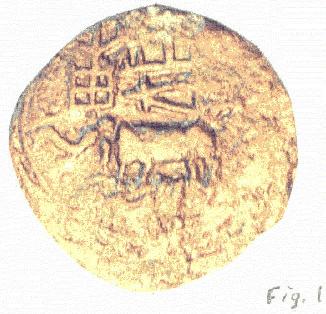
|
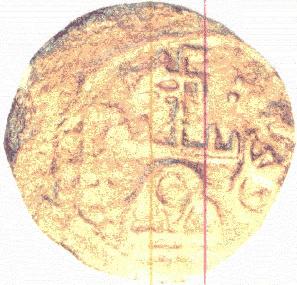
| |
| H1 Copper 18.47 gm 33 mm from Akurugoda | |
| The Lakshmi and railed swastika coins from both sites are of copper and were struck using two separate dies for the obverse and reverse, as opposed to the numerous elegantly cast coins, known to the collector. The cast coins are made by pouring molten copper between two moulds held together. The two Lakshmi coins present the numismatic researcher with a challenge - of identification and interpretation of their significance. The obverse (only) of a cast coin illustrated at (Fig.2) for comparison has a dimension of 32x17 mm and weighs 98.35 grains. The goddess Lakshmi is seen here as in most coins of the type standing on a large lotus flower grasping in her hands two lotus stalks growing from the same plant. |  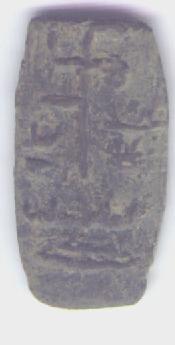 |
| H37 Lead 6.37 gm 32x17 mm from Akurugoda | |
| The coin excavated at Salgahawatta is intriguing and depicts a 'male figure' not the goddess Lakshmi and is of crude workmanship. The lotus stalks are distinctly 'straight' and resemble staves, a similar coin being illustrated at (Fig. 3). The coin excavated at Gedige however is less distinctly a 'male figure' and is of better workmanship where, above the head appears a distinct 'halo' with numerous rays (strokes) emanating inwards and towards the head. | 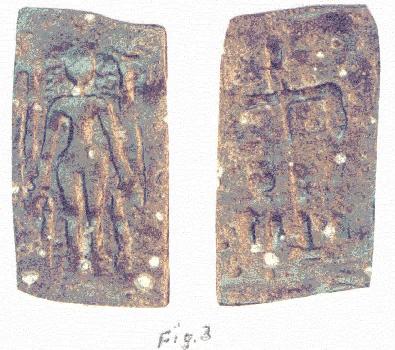
|
| Bronze 3.65 gm 34x18 mm from Anuradhapura Type H64-H67 in Ruhuna | |
| Another coin excavated from Gedige immediately above the level at which this coin was found had been a Lakshmi square shaped coin that is dated 2nd century BC. The railed swastika on this coin stands on a two-tier base, within a 'boat' like symbol, (Fig. 4). | 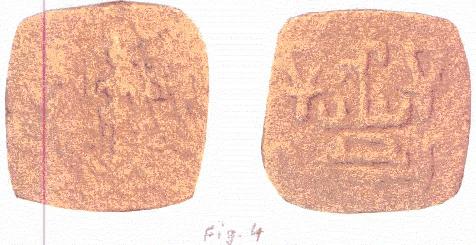
|
| H72 Bronze 9.66 gm 24x23 mm from Anuradhapura | |
| The 'tree' coins of this type usually have 3 to 7 branches with an enclosure (which is a base on railing) comprising of 2 to 16 compartments from which it rises. The coin illustrated (Fig. 5) is from Akurugoda in Tissamaharama (1999) with a dimension of 29 x 26 mm weighing 103.76 grains. | 
|
| H9 Lead 6.72 gm 29x26 mm from Akurugoda | |
| Occurring in this same level of dating at Salgahawatta, had been a small copper coin with a single elephant on the obverse and a railed Swastika on the reverse. See illustration (Fig. 6) for a similar coin from Akurugoda (1999). | 
|
| H19 Lead 1.99 gm 15x15 mm from Akurugoda | |
| Also from Salgahawatta, overlying this strata, had been found an 'elephant and stylised fish' coin referred to by Codrington as the 'Buddhist Cakram' of Pandyan derivation (Fig 8). Mitchiner (1978) in his 'Ancient and Classical World' notes that they were found predominantly in Madura with a few occurring in Ceylon. He dates the Madura and Ceylon coins together at 175 - 30 BC. | 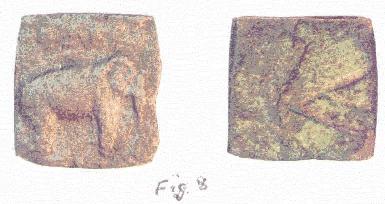
|
| Copper 2.62 gm 21x19 mm from Anuradhapura Unlisted in Ruhuna | |
| Codrington in 1925 described two other coins belonging to this period with the railed swastika and animals, namely the lion and the horse. Of interest to the collector comes a coin from another site in the Citadel, from Vijayabahu Palace, with a lion standing above a three cell caitya surrounded by a Brahmi legend and a railed swastika on the reverse. This is identifical to a coin found at Akurugoda (Fig. 7). | 
|
| E3 Lead 4.06 gm 22 mm from Akurugoda | |
That Sri Lankan indigenous coinage commenced between the 3rd and 2nd centuries BC should not be difficult to accept. The honour however of being the originator could rest between King Devanampiyatissa and his grand-son King Dutugamunu.